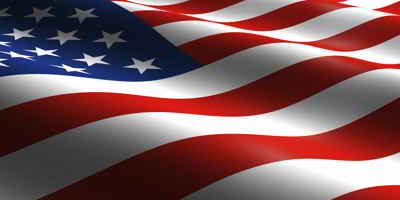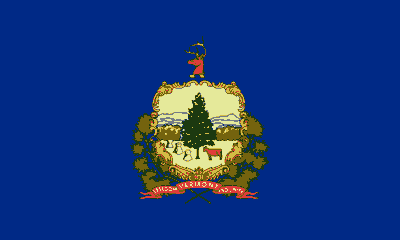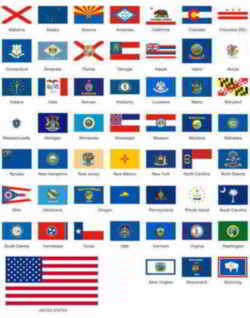

Vermont Symbols
Vermont State
Flag
Adopted on June 1, 1923.
The flag of the state of Vermont consists of the state's coat of arms and motto. The Vermont General Assembly adopted the current flag on June 1, 1923.
Multiple versions of the flag have been included throughout history. Originally, the flag was the same as the flag of the Green Mountain Boys. It was then changed to look similar to the flag of the United States, consisting of red and white stripes, and a blue canton. It was changed to be dissimilar to avoid confusion.Proposals have been brought up to revert the flag back to the Green Mountain Boys' flag, but none have succeeded.
The Vermont State Flag
The history of the Vermont state flag must include a reference to the United States flag,
adopted on June 14, 1777 and described as follows: "The flag of the United States shall be
thirteen stripes, alternate red and white, that the union be thirteen stars, white in a blue
field."*
After the admission of Vermont to the Union in 1791 and Kentucky in 1792, the design of the
US flag was changed by Congress in 1794 to include fifteen stripes and fifteen stars. This
design remained the National emblem until 1818, and was the flag which inspired Francis Scott
Key to write "The Star Spangled Banner," and is usually known as the Fort McHenry flag.** VT
State Flag
The first distinct Vermont flag was a state militia flag created on October 31, 1803. Tennessee
and Ohio had now been admitted into the Union and, apparently anticipating that the US flag
would continue to add stripes and stars for each addition, Vermont authorized a flag of seventeen
stripes and seventeen stars, "with the word 'VERMONT' in capitals above the said stripes and
stars." However, in April, 1818, Congress authorized our present United States flag of thirteen
stripes, with a star for each state.
The second Vermont flag, then, was authorized on October 20, 1838, and contained "thirteen
stripes, alternate red and white, and a union of one large star, white in a blue field, with
the coat-of-arms of the State of Vermont therein." This remained our state flag until 1919,
although it does not appear that this flag was ever used or displayed to any extent, nor even
that many people were familiar with its existence. In fact, when the desirability of a change
was in question, only a few of these state flags could be found.
It was felt that a distinctive Vermont flag should be created, one that as it hung on a pole
could not be confused with the United States flag. The second state flag had never been carried
as the state colors in any of the wars in which Vermont participated, but that the flag borne
by regiments of the State of Vermont in the Civil War, the Spanish-American War, the Mexican-Border
service and at the outbreak of World War I, was a flag having the state coat-of-arms on a blue
field. A flag of the same design had by custom also been carried as the Governor's flag. No.
8 of the Acts of 1919 approved the design of the official state flag as we know it today. (condensed
from an article entitled "History of the State Flag" by Herbert T. Johnson, Adjutant General,
1951 Vermont Legislative Directory. * The first Stars and Stripes Flag known to have been used
in the Revolutionary War was carried by the Green Mountain Boys of Vermont at the Battle of
Bennington, August 16, 1777, and is now the most cherished possession of the Bennington Historical
Museum, Bennington, Vermont.
**One of these flags is now in the Vermont Historical Society room in the Pavilion Building.
Source: Vermont Legislative Directory and State Manual prepared by the Secretary of State.
Symbolism
The flag consists of the state's coat of arms and motto on a field of azure. While the pine needle supporters of the coat of arms are represented throughout New England and symbolizes the small pine branches worn at the battle of Plattsburgh near the end of the War of 1812, the pine tree in the middle of the coat of arms represents the Vermont forests. The cow and three sheaves of wheat represent the dairy and agriculture industries. The deer head on top represents Vermont's wildlife. The Green Mountains are in the background as well. The motto, "Freedom and Unity", is also used. The motto balances two different ideals, the freedom of the individual citizen, and the welfare of the common good.
Vermont Coat of arms; crest; motto and badge
Vermont Statutes Annotated, Title 1, Chapter 11, Sections 491
01 VSA 491. Coat of arms; crest; motto and badge.
The coat of arms, crest, motto and badge of the state shall be and are described as follows:
Coat of arms. - Green, a landscape occupying half of the shield; on
the right and left, in the background, high mountains, blue; the sky, yellow. From near
the base and reaching nearly to the top of the shield, arises a pine tree of the natural
color and between three erect sheaves, yellow, placed diagonally on the right side and a
red cow standing on the left side of the field.
Motto and badge. - On a scroll beneath the shield, the motto: Vermont;
Freedom and Unity. The Vermonter's badge: two pine branches of natural color, crossed between
the shield and scroll.
Crest. - A buck's head, of natural color, placed on a scroll, blue
and yellow.
Vermont Flag Laws
Vermont Statutes Annotated, Title 1, Chapter 11, Sections 495-496
01 VSA § 495. State flag
The flag of the state shall be blue with the coat of arms of the state thereon.
01 VSA § 496. State flags, purchase, distribution
(a) The secretary of state shall, through the department of buildings
and general services, obtain state flags and a copy of the Bennington Battle Flag, so-called.
He may, in his discretion and on such terms as he finds appropriate, distribute said state
flags to other states, to state officials, departments and agencies, and to such other persons
as he may determine should have them in the interest of the state. He shall cause the Bennington
Battle Flag to be delivered to the custody of the Sergeant at Arms, to be flown at the State
House in Montpelier, under the United States Flag, on the 15th, 16th and 17th days of August
in each year to commemorate the Battle of Bennington.
(b) The secretary of state shall furnish to the division for historic preservation, under
this section, one Vermont state flag and one Bennington Battle Flag to be flown at the Bennington
Battle Monument Area. (1961, No. 120, § 1, eff. May 16, 1961; amended 1963, No. 77,§ 1,
2, eff. May 2, 1963; 1995, No. 148 (Adj. Sess.), § 4(a), eff. May 6, 1996.)

The Flags of the US.





